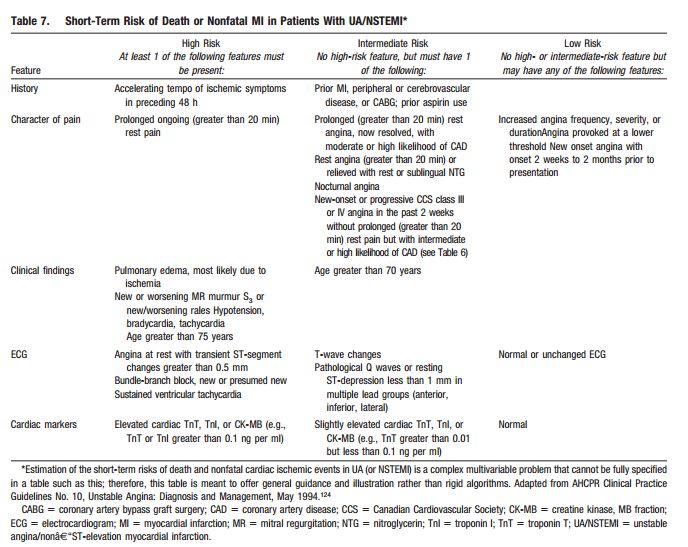Patients with unstable angina or non-ST elevation myocardial infarction are at intermediate risk of death or nonfatal myocardial infarction within hours or days of onset of symptoms if they have none of the high risk features (see post of December 26 or reference*) but have at least one of the following features:
A history of prior MI, peripheral or cerebrovascular disease, coronary artery bypass graft surgery, a history of prior aspirin use
 Prolonged (greater than 20 minutes) rest angina now resolved with a moderate or high likelihood coronary artery disease (see post of December 22 or Table 6, p e441*)
Prolonged (greater than 20 minutes) rest angina now resolved with a moderate or high likelihood coronary artery disease (see post of December 22 or Table 6, p e441*)
Rest angina (greater than 20 min) or angina relieved by rest or by sublingual nitroglycerin
Nocturnal angina
New onset or progressive Canadian Cardiovascular Society class III** or class IV*** angina in the past two weeks without prolonged (greater than 20 min) rest pain but with intermediate or high likelihood of coronary artery disease (Table 6, p e 441*)
Age greater than 70 years
T wave changes
Pathological Q waves or resting ST depression less than 1 mm in multiple lead groups (anterior, inferior, lateral)
Slightly elevated troponin T, troponin I, or CK-MB (e.g. troponin T greater than 0.01 but less than
0.1 ng per ml
*From the chart representing short term risk of death or nonfatal MI available in the 2011 AHA Unstable Angina/non-ST elevation myocardial infarction updated guidelines (Table 6, p e441 and Table 7, p e442) available at: https://circ.ahajournals.org/content/123/18/e426.full.pdf.
**Canadian Cardiovascular Society Class III angina is marked limitation of ordinary activity. [Angina occurs] walking one to two blocks on the level and climbing one flight of stairs in normal conditions and at normal pace
*** Canadian Cardiovascular Society Class IV angina [is the] inability to carry on any physical activity without discomfort, anginal syndrome may be present at rest
Above is from the Canadian Cardiovascular Society grading of angina pectoris available at
https://www.ccs.ca/download/position_statements/Grading%20of%20Angina.pdf





